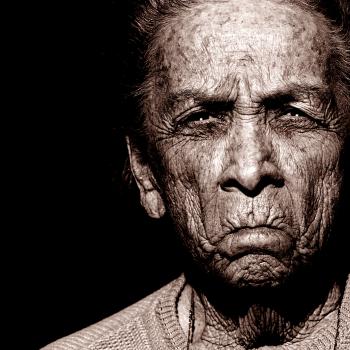 Want to try something really difficult? Be a researcher who studies religion in its many forms and facets using weird methods like computer simulations and lab psychology, and then try to explain your work to people who have normal careers. For example, you could go to a party and try explaining a paper my colleagues and I published last week on an agent-based model (ABM) computer simulation that explores why shamanism in some societies is mostly male-dominated, while in other societies shamans are mostly female. And you could explain why devoting computer and mental resources to this question is worthwhile. Better yet, pretend we’re at a party now. I’ve got about five minutes of your attention…maybe a few more if we’re trapped in the corner by the punch bowl. Let’s see how I do, shall we?
Want to try something really difficult? Be a researcher who studies religion in its many forms and facets using weird methods like computer simulations and lab psychology, and then try to explain your work to people who have normal careers. For example, you could go to a party and try explaining a paper my colleagues and I published last week on an agent-based model (ABM) computer simulation that explores why shamanism in some societies is mostly male-dominated, while in other societies shamans are mostly female. And you could explain why devoting computer and mental resources to this question is worthwhile. Better yet, pretend we’re at a party now. I’ve got about five minutes of your attention…maybe a few more if we’re trapped in the corner by the punch bowl. Let’s see how I do, shall we?
Shamanism: A Weird Obsession
There’s a very small, very unusual group of people (to which I belong) who really, really care what the definition of “shamanism” is. This over-educated and persnickety bunch can only agree that they can’t agree what it means. But I’ll give a shot at summing up some of the things it can mean. The word shaman, as I’ve discussed here previously, comes from the Siberian Tungus people. In that culture, it refers to people who are thought to have a special relationship with the spirits, who can communicate with the spirit world and use its resources to heal clients, augur the future, or gain special knowledge. Siberian shamans accomplish these tasks by going into a trance, aided (in part) by hypnotic drumming. In their altered states of consciousness, shamans believe they’re interacting with the spirit world on behalf of their clients, who are generally everyday members of the local village or community.
But these days the word “shaman” conventionally refers to a wide variety of similar practices across the world. There are “shamans” in Korea who go into spiritual trances to help clients. There are African “shamans” for whom drum-induced (and sometimes drug-induced) trance plays a central role. Japan, China, India, Southeast Asia, and the Americas have analogous institutions. In fact, although you wouldn’t think it from living in a WEIRD society like the U.S. or Western Europe (unless maybe you’re a Pentecostal), religious trances are nearly ubiquitous in human life. They’re almost like language or complex tool use: something that uniquely characterizes humans, setting us off from our animal relatives.
Cultural Variables and Types of Shamanism
But there are big differences in the way that shamans operate in distinct societies. In Siberia, shamans’ trances are generally described as being a kind of “out-of-body” experience, in which they leave their physical selves behind to spiritually travel to other realms. By contrast, in Korea, shamans give their bodies over to various spirits to be possessed. During trance rituals, with brass gongs rhythmically clanging, the bodies of Korean shamans are “taken over” by bodhisattvas, spirits, or clients’ dead ancestors, who speak with the shamans’ mouths to give information or warnings to clients. Korean shamanism is similar to Haitian Vodou, Brazilian Candomblé, and many similar institutions in in Africa and India (particularly among lower castes). Researchers sometimes call these religions “spirit possession cults.” Siberian shamanism, by contrast, features trance without possession.
Now, when you compare these religions or cults across societies, it turns out that spirit possession cults are much more likely to be A:) dominated demographically by women, and B:) found in societies that are complex, hierarchical, and sedentary. This means that trance religions that don’t feature spirit possession (such as Siberian shamanism) are disproportionately found in less structured, more mobile, less hierarchical societies, and disproportionately dominated by men. There are plenty of exceptions to this rule, but the general correlation is pretty clear. For example, in a recent commentary in Behavioral and Brain Sciences, my colleague Kate Stockly and I used cross-cultural ethnographic databases to show that female-dominate spirit possession cults correlate with larger population size, social hierarchy, and economic inequality.
Lots of ink has been spilled on why, exactly, women seem to dominate spirit-possession cults in hierarchical societies. But not as much attention has been paid to the question of why men dominate trance religions in smaller-scale societies. It might seem like a non-question: men often hoard power and prestige, so why would it be surprising that they dominate shamanic religions, too? Well, for one thing, women are typically much more active in religious life, regardless of religion or culture. So it’s at least a little bit odd that men are the majority in Siberian shamanism and its cousins in small-scale societies.
Shamans and Psychosocial Trauma
Shamans and religious trance practitioners are also often associated with psychosocial trauma, or extreme psychological stress. Women are usually thought to suffer more of this sort of stress than men do, in part because women are systematically subordinated and devalued across many of the earth’s cultures (not, as Salon.com would have you think, just in Western capitalist ones). In addition, women are subjected to the traumas of childbirth and often forced to do a disproportionate share of childcare work. So the oppression of women has often been used to explain why spirit possession cults, such as Korean shamanism or Haitian Vodou, are dominated by women.
But if religious trance is associated with trauma, then why are men typically the trance healers in smaller-scale societies? Don’t women suffer more trauma there, too? Well, there’s some data to suggest that male shamans in small-scale cultures tend to be otherwise socially marginal, or low-ranked. One expert on the Japanese Ainu remarks that:
men barred from access to the regular routes for political success are attracted to a shaman’s career. For example, a noted shaman…was blind and therefore could not engage in hunting, fishing, and other male activities which provide the means for males in Ainu society to achieve power.
This is an intriguing possibility. It suggests that shamanism might be an alternative form of securing social capital for people who can’t get it otherwise. This would be sort of like how some kids in high school attain popularity through the “normal” means, like playing varsity sports and throwing parties, while others – maybe less athletic or more introverted – carve out alternative niches in drama, or as musicians, or as dyed-haired punks. But again, for this particular strategy, why males?
We surveyed the literature to search for findings from other fields that might offer hints as to why males, in particular, might be drawn to alternative social strategies in small-scale cultures. We found two sets of interesting findings, one from physiology and one from evolutionary anthropology. First, in many contexts men respond more intensely to social stress than women do, as measured by activation of the hypothalamic-pituitary-adrenal (HPA) axis. This brain-and-gland circuit governs stress responses and the fight-or-flight response. It’s particularly responsive to social stressors. Signs of HPA axis activation such as cortisol reactivity are higher in men than in women after equivalently stressful experiences – especially those that have to do with competition or status.
Second, males in small-scale and acephalous (leaderless) cultures have steep informal status hierarchies, despite lacking a formal leadership structure. For example, prestige in small-scale societies often comes from success in hunting – yet only a few men usually bring home the bulk of the big, edible animals. Hunted game is an unpredictable and variable resource, unlike most types of foraging or horticulture, where the returns are lower but more reliable. Variable, high-return resources like game animals are shared widely across the hunter’s family and entire band. So good hunters gain prestige because they’re the guys everyone goes to for meat. But if only a few guys are killing most of the meat, then only those guys are getting the prestige.
Accordingly, in a fascinating study of hunter-gatherers in Africa, one team of anthropologists found that men had steeper, more unequal prestige hierarchies than women. Additionally, there was greater variation in membership in exclusive religious cults – which provide important social resources – between men than between women. So, in this officially egalitarian society, men were still subject to fairly high levels of status sorting, with some men getting lots of prestige and others getting not much at all. So how does this shed any light on the gender dynamics of shamanism?
The Actual Model, Finally
In agent-based models (ABMs, in case you weren’t paying attention), digital “agents” interact with each other inside simulated environments. They’re each programmed with decision rules that determine their behavior, so that when you run the simulation, fascinating group-level effects can emerge from thousands or millions of low-level interactions between individual agents that are just obeying their own rules. As a postdoc on the Modeling Religion Project, I teamed up with computer simulation experts at the Virginia Modeling, Analysis, and Simulation Center (VMASC) in Suffolk, Virginia, to build an ABM of the gender dynamics of shamanism.
Each agent in our model was assigned a gender (male or female) and a “rank” (1-10). The social rank represented formal hierarchical differences, such as between an aristocrat and a commoner. But we also accounted for informal prestige hierarchy, like those in acephalous societies, by adding competition between males of the same rank. During each time step of the model, male agents survey their immediate neighborhood (each of the eight grid cells that surround them)* and, if they find a male of the same rank, they “compete” with that agent with a probability inversely proportionate to the number of formal ranks in the society. This decision reflected the fact that hierarchies are more unsettled in formally unstructured societies, where, according to anthropologist Mary Douglas, “the form of organization is competitive, with dominant positions open to merit.”**
At each time step, agents of both genders calculate their level of social stress, or dissatisfaction. Stress is calculated by comparing the agents’ social rank to the mean of the ranks of all its immediate neighbors. So if your rank is only 2, and your immediate neighbors are ranked 5, 7, and 6, your satisfaction level for that time step would be -4. This operation reflected findings in social and organizational science that sheer subordination in a structural hierarchy is often stressful to the point of causing real illness. Additionally, male agents augment their satisfaction score with information about their recent defeats or victories in informal status competition with other males.
Agents also each have a “somatization threshold,” which just means there’s a certain level of dissatisfaction or stress they can experience before they start exhibiting dissociative symptoms. (This is a binary, or boolean, attribute – agents either dissociate or not.) Dissociation is a psychological syndrome characterized by anomalous perceptual experiences, trances, and “spacing out.” It’s often a result of trauma. Many of its symptoms are very similar to those that shamans in many cultures exhibit when they first start feeling “called” to become shamans (“spirit sickness” or 신볗 in Korea).
Finally, agents who are dissociating – that is, who are exhibiting psychological symptoms of trauma – receive feedback from their neighbors about what to do. If enough neighbors “vote” that the agent should become a shaman, it does. This operation reflects the fact that who enters the shaman role depends on social and cultural feedback. Once an agent becomes a shaman, its own votes count much more highly, because in real societies it’s actual shamans that usually make the decisions about who’s suited – or being called by the spirits – to follow in their footsteps.
Testing the Model
When we tested the model initially, we found that a flatter social structure led, indeed, to a higher ratio of male shamans than female shamans. For these tests, the somatization threshold parameter wasn’t allowed to vary. But in our next set of experiments, somatization wasn’t fixed, and something interesting happened: when we told the program (AnyLogic v. 8) to maximize the ratio of male shamans to female shamans, males had slightly lower somatization thresholds. That is, they responded more strongly to competitive social stress – which is what findings in the physiological literature suggest is actually the case. The society was also comparatively flat, with all male agents occupying a rank of either 2, 3, or 4. By contrast, when we asked the program to maximize the female-to-male ratio of shamans, the social hierarchy got much steeper, and males and females had identical somatization parameters.
But these simulations were a bit unrealistic. For one thing, when we maximized the proportion of female shamans, it turned out that every female agent had become a shaman by the end of the simulation run. More than 80% of males were shamans, too. In real-world societies, shamans are usually (not always, but usually) a small minority of people, so we next asked the simulation engine to give us a high male-to-female ratio of shamans without any constrain on the relative ranks of genders. We got, in return, a simulated society in which more males than females were shamans, but where shamans were only a small minority.
We then stipulated that there must be only two ranks – “2” for males and “1” for females – while holding all other parameters constant from the previous experiment. (This decision reflected anthropological research showing that, even in otherwise egalitarian foraging societies, men are unfortunately often despotic toward women.) The resulting simulation gave us a society where the vast majority of shamans were men, but only 12.5% of all male agents were shamans at the end of a 30-year simulated time period. These ratios were similar to real-world data, which shows that shamans are usually specialized professionals, forming a small minority.
Again holding all the other parameter values constant, we created a shallow, staggered hierarchy in which male agents decisively outranked females, although they also experienced strong inequality amongst themselves. The result was a society in which women were the majority of shamans, but only about 13% of agents were shamans. In each of these simulations, males had a lower tolerance for social stress than females, in line with the physiological findings above.
In other words, our very simple ABM “grew” social phenomena that occur regularly across cultures worldwide, but which nobody has really been able to understand. In our simulations, steeper formal social hierarchies produced societies with more female shamans, and more egalitarian societies gave rise to male-dominated shamanism. In the most realistic simulations, males were slightly less tolerant of social stress than female agents. We concluded that
there is good reason to think that structurally flat societies may be characterized not solely by Edenic egalitarianism, but also by persistently unresolved interspecific competition and unstable, churning informal status hierarchies.…dissociative responses to psychosocial stress can become spotlights, shining on the fractures in a social order or the places where dominant cognitive schemas break down, lose their moral legitimacy, or are simply no longer useful for making sense of suffering.
What Does It Mean?
Well, I’ve clearly failed at the party-and-punch bowl task. This is a long blog post. But if you can bear with me for three more paragraphs, I’ll zoom back out and ask what these results mean. For starters, they don’t mean we’ve identified the reason why males dominate trance religions in small-scale societies. A computer model isn’t a real-world experiment. And you astute readers have surely noticed that we essentially built some of our assumptions into the model – particularly that males experience more informal social competition than females do. This assumption matches ethnographic research, but since it’s an axiomatic assumption of the model, the model can’t test whether it’s plausible.
Instead, it demonstrates that, if we bundle all our assumptions into a single, integrated model, we can reproduce effects that we know occur in the real world under realistic parameter settings. By contrast, if we could only get the model to give us a male majority of shamans by configuring it in a totally unrealistic way (say, by having males be much more sensitive to social stress than females, or having females significantly outrank males politically***), then that would be evidence that there was something wrong with the theory. As it stands, we’ve got proof-of-concept that our model and the theory it reflects aren’t bogus.
That might not sound very exciting. But sometimes, in the human sciences, just learning that an idea isn’t bogus is a big deal indeed. It gives you permission to keep looking in the direction you were looking in. It might suggest avenues for real-world experiments and testing. For something as complicated, arcane, and hard-to-quantify as shamanism, this is a great first step. As far as I know, it’s also the first sustained attempt to investigate why men dominate shamanism in small-scale, egalitarian societies, not just why women dominate it in hierarchical ones. Being able to “grow” both sides of this strange and wonderful phenomenon in a digital petri dish is an advance – a small one, but an advance – toward greater knowledge of how humans work.
_____
Additional note: Our paper was published in a special issue of the Journal of Cognition and Culture completely focused on computer modeling and simulation in the human and cultural sciences. Many of my colleagues on the Modeling Religion Project have articles in the same issue. Check it out here.
_____
* That’s a Moore neighborhood, for all you computer modeling-and-simulation geeks.
** For example, in political philosophy it’s a truism that meritocracy and formal aristocracy are incompatible. On this account, the United States is a highly competitive society precisely because it’s so ideologically egalitarian and individualistic: without ascribed or arbitrarily inherited social ranks, we Americans have traditionally sorted ourselves according to competitive achievement. Our shamanism model posited that the same sort of thing is going on in smaller-scale, itinerant, and acephalous societies, which tend to be highly ideologically egalitarian and have few formal or ascribed statuses.
*** Again, saying that it would be unrealistic if females outranked men politically isn’t a normative claim. It’s just an acknowledgment of the ethnographic finding that men across many societies tend to boss women around, even when they don’t boss each other around. While occasionally someone claims that some isolated society is matriarchal – politically led by women – the society in question is usually actually matrilineal, where descent and family names come from the mother’s side. Societies differ widely in how much respect women get. Some societies are much more gender-equal than others. But nobody has conclusively found a true matriarchal society, and the consensus among anthropologists is that true matriarchy probably doesn’t exist in the way some utopian thinkers have claimed.
_____
And now for something completely different! Want to participate in a cool study? Check out this online survey on how people conceptualize God’s personality. The authors of the study describe it like this:
Researchers from the University of Oxford and Zagreb University are trying to understand how people see God’s personality. For some religions god is wrathful, for others god is forgiving, for others still god is removed from our immediate concern. We want to better understand what is behind these different traits for God concepts. Our new survey is designed to try and help test new measures for how we understand god’s personality.
All the cool research I write about wouldn’t be possible without people participating in studies to help researchers understand religion, culture, and evolution. So now’s your chance to take part. The survey takes around 20 minutes – a nice lunchtime break.












